An official website of the United States government
 United States Department of Labor
United States Department of Labor
Lay, repair, and maintain track for standard or narrow-gauge railroad equipment used in regular railroad service or in plant yards, quarries, sand and gravel pits, and mines. Includes ballast cleaning machine operators and railroad bed tamping machine operators.
Employment estimate and mean wage estimates for this occupation:
| Employment (1) | Employment RSE (3) |
Mean hourly wage |
Mean annual wage (2) |
Wage RSE (3) |
|---|---|---|---|---|
| 16,180 | 8.1 % | $27.48 | $57,160 | 4.0 % |
Percentile wage estimates for this occupation:
| Percentile | 10% | 25% | 50% (Median) |
75% | 90% |
|---|---|---|---|---|---|
| Hourly Wage | $16.71 | $20.93 | $26.97 | $34.09 | $39.12 |
| Annual Wage (2) | $34,770 | $43,530 | $56,100 | $70,910 | $81,380 |
Industries with the highest published employment and wages for this occupation are provided. For a list of all industries with employment in this occupation, see the Create Customized Tables function.
Industries with the highest levels of employment in this occupation:
| Industry | Employment (1) | Percent of industry employment | Hourly mean wage | Annual mean wage (2) |
|---|---|---|---|---|
| Rail Transportation | 9,720 | 4.15 | $25.84 | $53,750 |
| Local Government, excluding schools and hospitals (OES Designation) | 3,130 | 0.06 | $34.53 | $71,820 |
| Other Heavy and Civil Engineering Construction | 1,540 | 1.25 | $21.25 | $44,200 |
| State Government, excluding schools and hospitals (OES Designation) | 870 | 0.04 | $35.94 | $74,740 |
| Support Activities for Rail Transportation | 360 | 1.01 | $21.47 | $44,660 |
Industries with the highest concentration of employment in this occupation:
| Industry | Employment (1) | Percent of industry employment | Hourly mean wage | Annual mean wage (2) |
|---|---|---|---|---|
| Rail Transportation | 9,720 | 4.15 | $25.84 | $53,750 |
| Other Heavy and Civil Engineering Construction | 1,540 | 1.25 | $21.25 | $44,200 |
| Support Activities for Rail Transportation | 360 | 1.01 | $21.47 | $44,660 |
| Scenic and Sightseeing Transportation, Land | 40 | 0.29 | $15.55 | $32,340 |
| Local Government, excluding schools and hospitals (OES Designation) | 3,130 | 0.06 | $34.53 | $71,820 |
Top paying industries for this occupation:
| Industry | Employment (1) | Percent of industry employment | Hourly mean wage | Annual mean wage (2) |
|---|---|---|---|---|
| State Government, excluding schools and hospitals (OES Designation) | 870 | 0.04 | $35.94 | $74,740 |
| Local Government, excluding schools and hospitals (OES Designation) | 3,130 | 0.06 | $34.53 | $71,820 |
| Coal Mining | 30 | 0.06 | $29.73 | $61,840 |
| Rail Transportation | 9,720 | 4.15 | $25.84 | $53,750 |
| Commercial and Industrial Machinery and Equipment (except Automotive and Electronic) Repair and Maintenance | 80 | 0.04 | $22.98 | $47,800 |
States and areas with the highest published employment, location quotients, and wages for this occupation are provided. For a list of all areas with employment in this occupation, see the Create Customized Tables function.
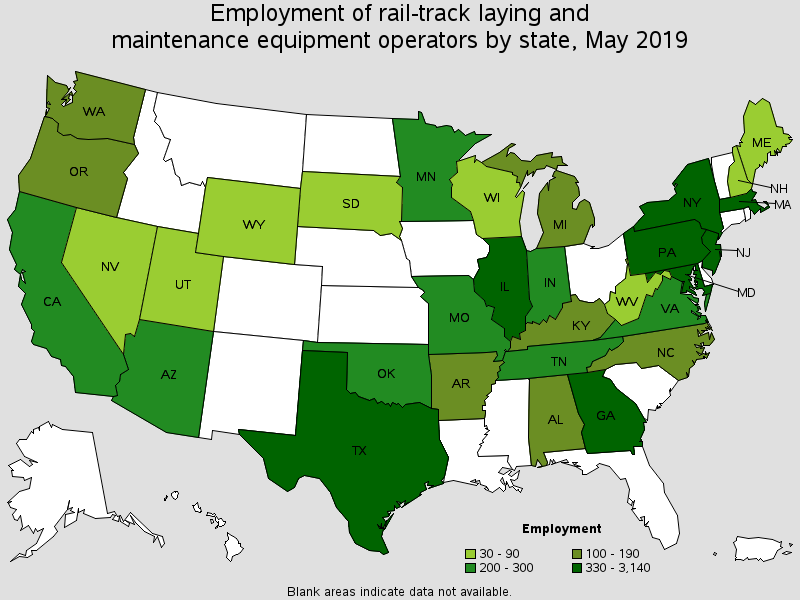
States with the highest employment level in this occupation:
| State | Employment (1) | Employment per thousand jobs | Location quotient (9) | Hourly mean wage | Annual mean wage (2) |
|---|---|---|---|---|---|
| New York | 3,140 | 0.33 | 3.00 | $34.01 | $70,740 |
| Texas | 970 | 0.08 | 0.71 | $26.39 | $54,890 |
| Illinois | 810 | 0.13 | 1.22 | $27.15 | $56,460 |
| Pennsylvania | 800 | 0.14 | 1.23 | $27.26 | $56,690 |
| Massachusetts | 780 | 0.22 | 1.96 | $36.69 | $76,320 |
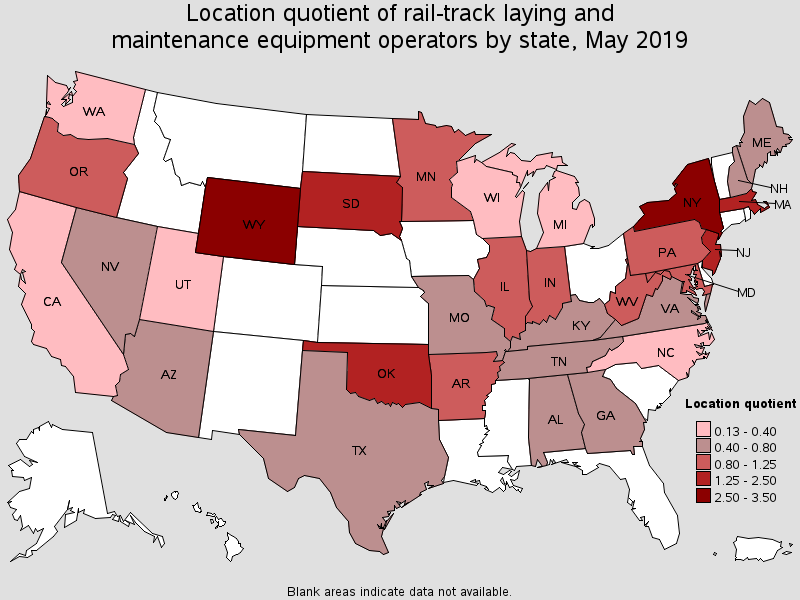
States with the highest concentration of jobs and location quotients in this occupation:
| State | Employment (1) | Employment per thousand jobs | Location quotient (9) | Hourly mean wage | Annual mean wage (2) |
|---|---|---|---|---|---|
| New York | 3,140 | 0.33 | 3.00 | $34.01 | $70,740 |
| Wyoming | 90 | 0.32 | 2.91 | $32.57 | $67,750 |
| Massachusetts | 780 | 0.22 | 1.96 | $36.69 | $76,320 |
| Oklahoma | 270 | 0.16 | 1.49 | $18.94 | $39,400 |
| South Dakota | 60 | 0.15 | 1.34 | $21.34 | $44,390 |
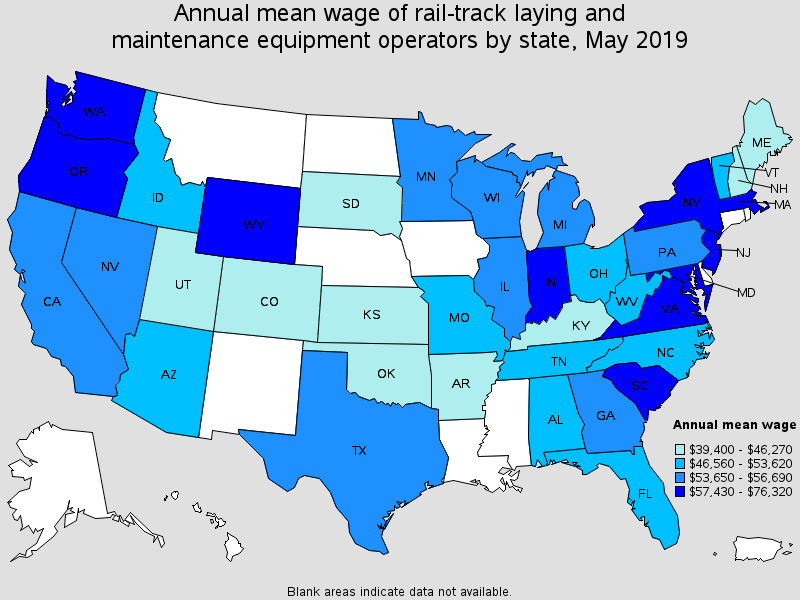
Top paying States for this occupation:
| State | Employment (1) | Employment per thousand jobs | Location quotient (9) | Hourly mean wage | Annual mean wage (2) |
|---|---|---|---|---|---|
| Massachusetts | 780 | 0.22 | 1.96 | $36.69 | $76,320 |
| New York | 3,140 | 0.33 | 3.00 | $34.01 | $70,740 |
| Wyoming | 90 | 0.32 | 2.91 | $32.57 | $67,750 |
| Maryland | 330 | 0.12 | 1.10 | $30.11 | $62,640 |
| Oregon | 190 | 0.10 | 0.92 | $30.10 | $62,610 |
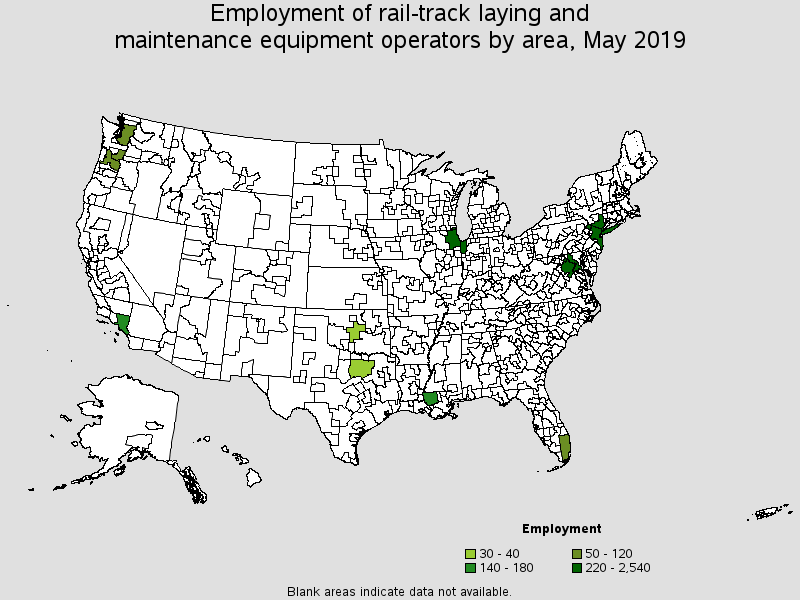
Metropolitan areas with the highest employment level in this occupation:
| Metropolitan area | Employment (1) | Employment per thousand jobs | Location quotient (9) | Hourly mean wage | Annual mean wage (2) |
|---|---|---|---|---|---|
| New York-Newark-Jersey City, NY-NJ-PA | 2,540 | 0.26 | 2.39 | $34.94 | $72,680 |
| Washington-Arlington-Alexandria, DC-VA-MD-WV | 350 | 0.11 | 1.01 | $32.62 | $67,850 |
| Chicago-Naperville-Elgin, IL-IN-WI | 220 | 0.05 | 0.43 | $28.72 | $59,730 |
| Los Angeles-Long Beach-Anaheim, CA | 180 | 0.03 | 0.27 | $24.20 | $50,340 |
| Baton Rouge, LA | 140 | 0.36 | 3.26 | $28.48 | $59,230 |
| Seattle-Tacoma-Bellevue, WA | 120 | 0.06 | 0.53 | $29.75 | $61,870 |
| Portland-Vancouver-Hillsboro, OR-WA | 80 | 0.07 | 0.61 | $32.46 | $67,510 |
| Miami-Fort Lauderdale-West Palm Beach, FL | 50 | 0.02 | 0.17 | $21.79 | $45,320 |
| Dallas-Fort Worth-Arlington, TX | 40 | 0.01 | 0.11 | $27.51 | $57,220 |
| Oklahoma City, OK | 30 | 0.05 | 0.45 | $15.27 | $31,750 |
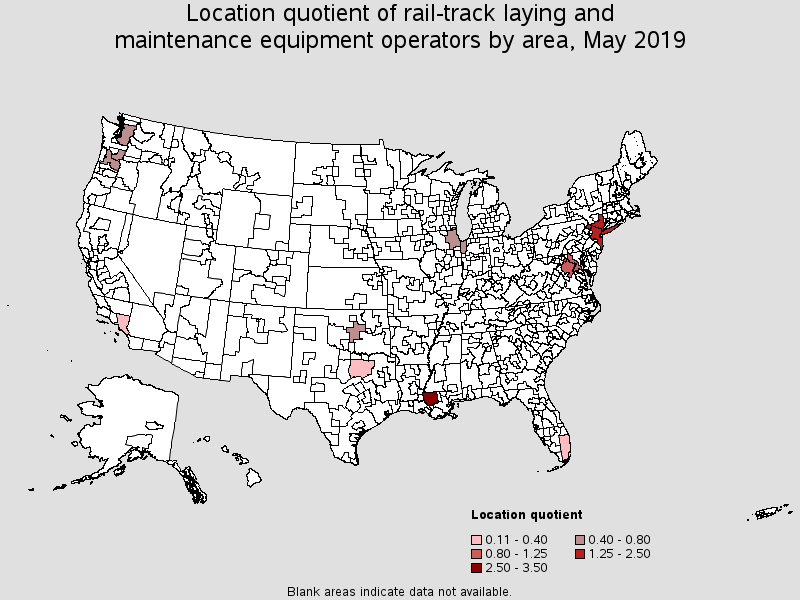
Metropolitan areas with the highest concentration of jobs and location quotients in this occupation:
| Metropolitan area | Employment (1) | Employment per thousand jobs | Location quotient (9) | Hourly mean wage | Annual mean wage (2) |
|---|---|---|---|---|---|
| Baton Rouge, LA | 140 | 0.36 | 3.26 | $28.48 | $59,230 |
| New York-Newark-Jersey City, NY-NJ-PA | 2,540 | 0.26 | 2.39 | $34.94 | $72,680 |
| Washington-Arlington-Alexandria, DC-VA-MD-WV | 350 | 0.11 | 1.01 | $32.62 | $67,850 |
| Portland-Vancouver-Hillsboro, OR-WA | 80 | 0.07 | 0.61 | $32.46 | $67,510 |
| Seattle-Tacoma-Bellevue, WA | 120 | 0.06 | 0.53 | $29.75 | $61,870 |
| Oklahoma City, OK | 30 | 0.05 | 0.45 | $15.27 | $31,750 |
| Chicago-Naperville-Elgin, IL-IN-WI | 220 | 0.05 | 0.43 | $28.72 | $59,730 |
| Los Angeles-Long Beach-Anaheim, CA | 180 | 0.03 | 0.27 | $24.20 | $50,340 |
| Miami-Fort Lauderdale-West Palm Beach, FL | 50 | 0.02 | 0.17 | $21.79 | $45,320 |
| Dallas-Fort Worth-Arlington, TX | 40 | 0.01 | 0.11 | $27.51 | $57,220 |
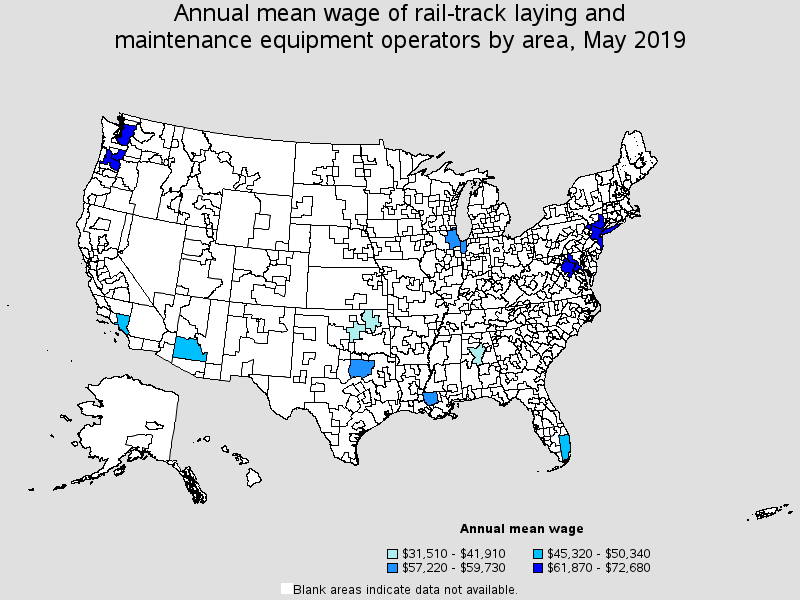
Top paying metropolitan areas for this occupation:
| Metropolitan area | Employment (1) | Employment per thousand jobs | Location quotient (9) | Hourly mean wage | Annual mean wage (2) |
|---|---|---|---|---|---|
| New York-Newark-Jersey City, NY-NJ-PA | 2,540 | 0.26 | 2.39 | $34.94 | $72,680 |
| Washington-Arlington-Alexandria, DC-VA-MD-WV | 350 | 0.11 | 1.01 | $32.62 | $67,850 |
| Portland-Vancouver-Hillsboro, OR-WA | 80 | 0.07 | 0.61 | $32.46 | $67,510 |
| Seattle-Tacoma-Bellevue, WA | 120 | 0.06 | 0.53 | $29.75 | $61,870 |
| Chicago-Naperville-Elgin, IL-IN-WI | 220 | 0.05 | 0.43 | $28.72 | $59,730 |
| Baton Rouge, LA | 140 | 0.36 | 3.26 | $28.48 | $59,230 |
| Dallas-Fort Worth-Arlington, TX | 40 | 0.01 | 0.11 | $27.51 | $57,220 |
| Los Angeles-Long Beach-Anaheim, CA | 180 | 0.03 | 0.27 | $24.20 | $50,340 |
| Phoenix-Mesa-Scottsdale, AZ | (8) | (8) | (8) | $22.29 | $46,370 |
| Miami-Fort Lauderdale-West Palm Beach, FL | 50 | 0.02 | 0.17 | $21.79 | $45,320 |
These estimates are calculated with data collected from employers in all industry sectors, all metropolitan and nonmetropolitan areas, and all states and the District of Columbia. The top employment and wage figures are provided above. The complete list is available in the downloadable XLS files.
The percentile wage estimate is the value of a wage below which a certain percent of workers fall. The median wage is the 50th percentile wage estimate--50 percent of workers earn less than the median and 50 percent of workers earn more than the median. More about percentile wages.
(1) Estimates for detailed occupations do not sum to the totals because the totals include occupations not shown separately. Estimates do not include self-employed workers.
(2) Annual wages have been calculated by multiplying the hourly mean wage by a "year-round, full-time" hours figure of 2,080 hours; for those occupations where there is not an hourly wage published, the annual wage has been directly calculated from the reported survey data.
(3) The relative standard error (RSE) is a measure of the reliability of a survey statistic. The smaller the relative standard error, the more precise the estimate.
(8) Estimate not released.
(9) The location quotient is the ratio of the area concentration of occupational employment to the national average concentration. A location quotient greater than one indicates the occupation has a higher share of employment than average, and a location quotient less than one indicates the occupation is less prevalent in the area than average.
Other OES estimates and related information:
May 2019 National Occupational Employment and Wage Estimates
May 2019 State Occupational Employment and Wage Estimates
May 2019 Metropolitan and Nonmetropolitan Area Occupational Employment and Wage Estimates
May 2019 National Industry-Specific Occupational Employment and Wage Estimates
Last Modified Date: July 6, 2020